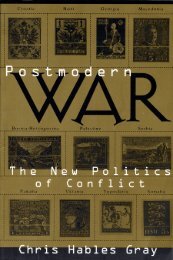9. The Systems of Postmodern War - Chris Hables Gray
9. The Systems of Postmodern War - Chris Hables Gray
9. The Systems of Postmodern War - Chris Hables Gray
Create successful ePaper yourself
Turn your PDF publications into a flip-book with our unique Google optimized e-Paper software.
[ 180 ] <strong>The</strong> Past<br />
seems to fade in and out as you look at it, leaving only its mocking<br />
smile—bedevils efforts at comprehension, (p. 16-1)<br />
<strong>The</strong> term "low-intensity" suggests a contrast to mid- or high-intensity<br />
conflict—a spectrum <strong>of</strong> warfare. Low-intensity conflict, however, cannot<br />
be understood to mean simply the degree <strong>of</strong> violence involved. Low-intensity<br />
conflict has more to do with the nature <strong>of</strong> the violence—the<br />
strategy that guides it and the way individuals engage each other in<br />
it—than with level or numbers, (p. 1-2)<br />
<strong>The</strong>se definitions are both from the same report. This obvious tension, even<br />
disagreement, about the meaning and definition <strong>of</strong> LIC is considered a<br />
serious problem: "No single issue has impeded the development <strong>of</strong> policy,<br />
strategy, doctrine, training, or organizations more than the lack <strong>of</strong> an approved<br />
definition <strong>of</strong> low-intensity conflict" (p. 1-2). Finally, after "years" <strong>of</strong><br />
work, the Joint Chiefs approved an <strong>of</strong>ficial definition:<br />
Low-intensity conflict is a limited politico-military struggle to achieve<br />
political, social, economic, or psychological objectives. It is <strong>of</strong>ten protracted<br />
and ranges from diplomatic, economic, and psychosocial pressures<br />
through terrorism and insurgency. Low-intensity conflict is generally<br />
confined to a geographic area and is <strong>of</strong>ten characterized by constraints on<br />
the weaponry, tactics, and the level <strong>of</strong> violence, (p. 1-2)<br />
Notice how the definition must be formal, like a computer language. <strong>The</strong><br />
longer definition hashed out by the project is an even greater reflection <strong>of</strong><br />
this. It includes five major subcategories: Insurgency; Counterinsurgency;<br />
Terrorism Counteraction; Peacetime Contingency; and Peacekeeping.<br />
Included within the category <strong>of</strong> Peacetime Contingency are many violent<br />
actions (although they use the euphemism "conditions" that are "short <strong>of</strong><br />
conventional war." Some <strong>of</strong> the specifics mentioned are "strike, raid, rescue,<br />
recovery, demonstration, show <strong>of</strong> force, unconventional warfare, and intelligence<br />
operations" (p. 1-3; cited from TRADOC Pam. 525-44). <strong>The</strong>se are<br />
obviously options usually for the "local" arena, the second crucial battle site:<br />
<strong>The</strong> local arena is crucial because <strong>of</strong> two significant developments: the<br />
emergence since World <strong>War</strong> II <strong>of</strong> a number <strong>of</strong> new, independent states<br />
whose sociopolitical stability is <strong>of</strong>ten fragile;and the growth (in various<br />
societies) <strong>of</strong> groups, <strong>of</strong>ten with international connections, that are dedicated<br />
to radical change through violent means, (p. 1-4)<br />
To explain this threat, the report uses a strange mix <strong>of</strong> historical and<br />
Manichaean assumptions. First, the problem is the instability caused by the<br />
postmodern collapse <strong>of</strong> colonialism and the resultant crisis <strong>of</strong> modernization.








